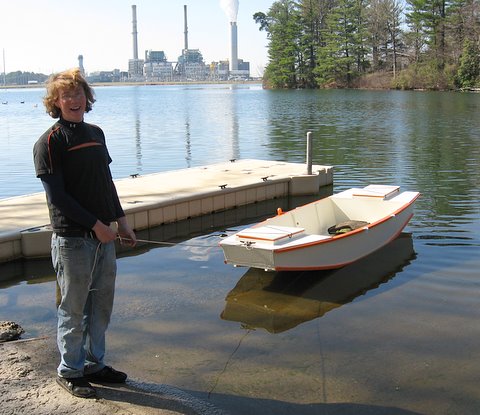
Sean Moffitt, of the Georgia Moffitts, launches this Piccup Squared he built by himself.
Contents:
Contact info:
Jim Michalak
118 E Randall,
Lebanon, IL 62254Send $1 for info on 20 boats.
Jim Michalak's Boat Designs
118 E Randall, Lebanon, IL 62254
A page of boat designs and essays.
(1Apr09)This issue will take a look at a new design. The 15 April issue will rerun the Rigging Sharpie Sails issue.
THE BOOK IS OUT!
BOATBUILDING FOR BEGINNERS (AND BEYOND)
is out now, written by me and edited by Garth Battista of Breakaway Books. You might find it at your bookstore. If not check it out at the....ON LINE CATALOG OF MY PLANS...
...which can now be found at Duckworks Magazine. You order with a shopping cart set up and pay with credit cards or by Paypal. Then Duckworks sends me an email about the order and then I send the plans right from me to you.

|
Left:
Sean Moffitt, of the Georgia Moffitts, launches this Piccup Squared he built by himself.
|
|
|
Laguna
DOWN IN TEXAS....
They started a "cruise", not really a race, 200 miles up the protected waters of the intercoastal waterway. They say the wind blows strong and from such a direction that you reach or run the whole way and usually in smooth water. The area is pretty unpopulated and in the several days it takes to make the run you must be self sufficient including taking all your food and water needed.
One participant wanted to build a boat for the event and started with a look at Raider. Raider was also made for a "race" but in the Baltic where the wind is not nearly so reliable, thus it was also meant to row well. The Raider crew always bunks on shore, in splendor, so carrying gear in the boat is not really required.
The Texas boat was to have a crew of two and it would best if those two could sleep on the floor of the boat although storage would be needed for a tent also. Plus all the rest for several days including a few hundred pounds of fresh water. So it would have to be different from Raider. No need for that somewhat elaborate V bottomed shape, either, since it was expected to be max hull speed reaching and running in smooth water. So a flat bottom was fine. CL also suggested the simplest possible construction, maybe even be able to build it on site in the days before the race.
I doodled some doodles and decided to try a lenthened version of Mayfly16, the prototype shown here by Tom Fulk:
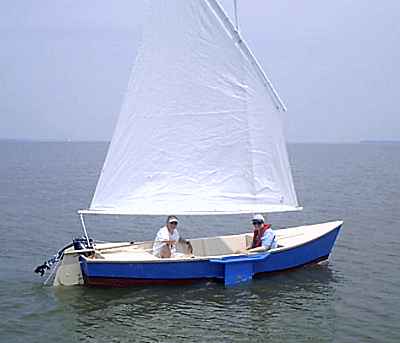
If you're gonna lengthen it, might as well add 8' or so, the length of a plywood panel. I was asked to keep the bottom narrow enough to plank over with a single width of plywood, 4', like Mayfly16. The sail rig was also to be kept simple and need not be large given the usual strength of the wind there. My second or third doodle looked like this:
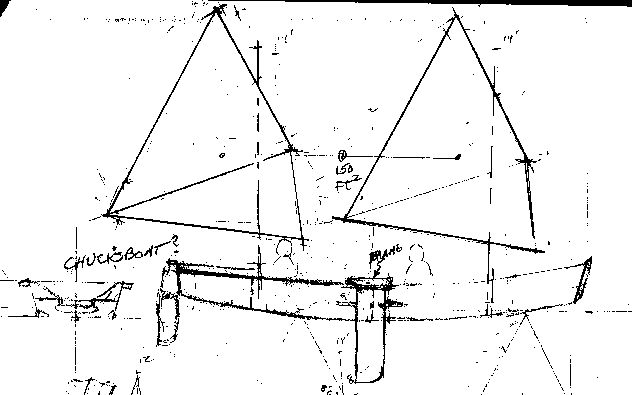
The two sails and masts are the same as my Ladybug rig, something CL already has on hand, at least one of them anyway. Then there is a plan to have the ability to mount a solo mast in the boat's center.
So in general we have a long skinny flat bottomed sailing skiff of the simplest sort of construction. There are two cockpits so the sailors can sulk and mope apart from one another on the long trip, no need for mutiny or worse. The cockpits are each 6.5' long so sleeping on the floor is possible. There are storage/buoyancy chambers fore and aft. They should help a lot in a knockdown but a boat with 13' of open cockpit can swallow a huge amount of water in a knockdown. One thing that might help a lot in such a situation is to tie large air filled fenders outside of the top wale to give the narrow boat broader shoulders to lift it when it goes sideways.
At first I gave it long bench seats like Mayfly16's but on second thought I changed to individual seats that cross the backs of the cockpits. On a trip this long you must be comfortable. These should be quickly removable to allow clearing for the sleeping spot. The bench seats simply can't allow a center aisle wide enough for sleeping. I might add that if the boat were used on occasion to take out a very numerous crew, say a family reunion, then I would suggest leaving the seats on shore and have all sit on the floor. Then again, if you are never to sleep in the boat you might install the bench seats, which can be somewhat complicated but usually provide the best comfort. Anyway, the side view cross section ended up looking like this:
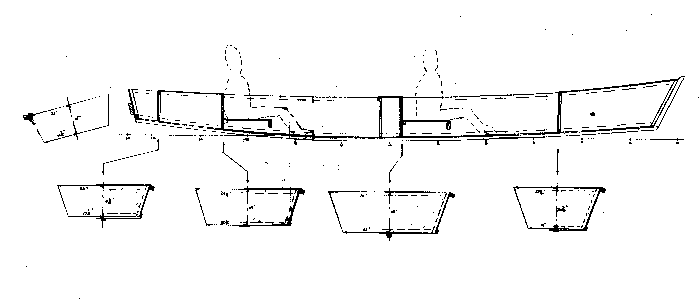
I drew up the expanded panels and made a card model that looked like this:
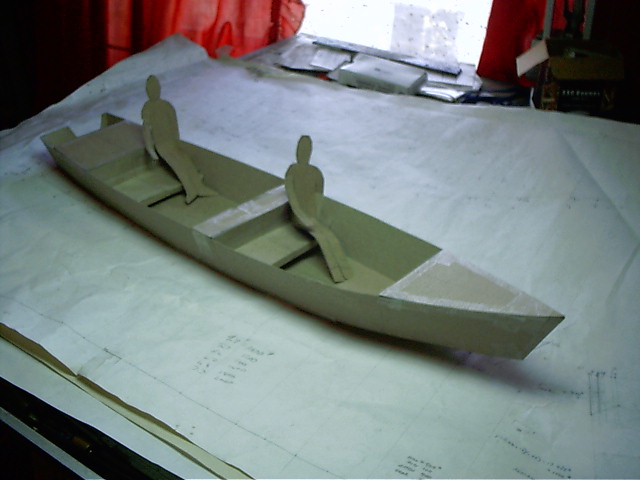
It stern has my usual open well with a place for a small motor. I drew up the sail rig in more detail and got this:
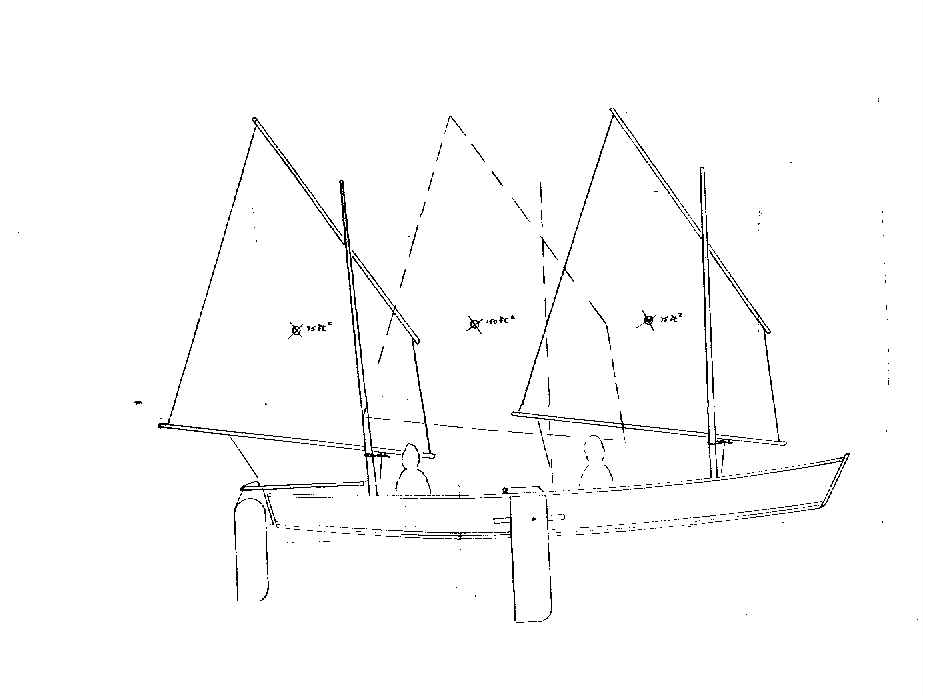
No real change here from the original cartoon but I've shown the single mast setup in dashed lines. The tiller of such a boat always bothered me. The masts are on centerline. The tiller has to end short of the mast of course to allow it to swing. So the skipper has to hand it back and forth to himself sometimes on tacks. I think what I show is the best approach, or at least the simplest. Any other rig would require some linkage or perhaps a large oddball tiller. This should work OK given the long stretches with no tacks required in the race.
About this time, with the design pretty much set, I made up a Hullform model which looked like this:
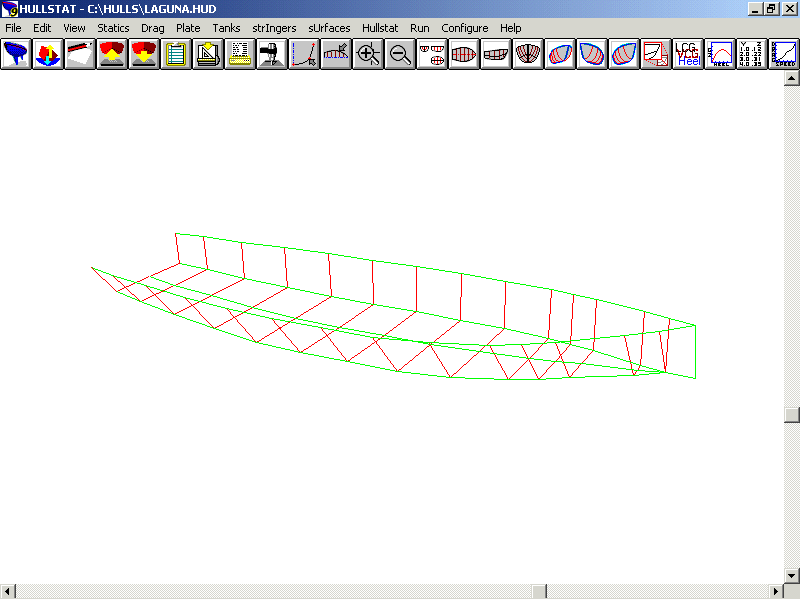
The program doesn't seem to allow slanted stems and transoms so it isn't exactly per the drawing. These are very good at scoping out displacement, although with such a simple design you can do OK with a quick hand calc. For example here, if the boat were loaded down to where its stem hits the water, what I would call the maximum displacement (although the boat could clearly take a lot more weight with ugly flow lines), then the waterline length would be about 21'. The maximum submerged cross section would be about 7" x 48" in area (draft times beam) which is 336 sq in which is 2.33 sq ft. So a "prizm" 21' x 2.33' would have a volume of 49 cubic feet. Boats like this almost always have a "prizmatic coefficient" of about .55, so I would expect the real boat to have a displaced volume, at 7" draft" of .55 x 49 which equals 27 cu ft of water. Water weighs about 63 pounds per cubic foot so that displacement amounts to 1700 pounds of displacement. The Hullform model predicts 2000 pounds displacement at 7" draft so perhaps the difference is partly because the side flare gives a bit more displacement and perhaps the hull is fuller in the ends than the norm. I think the higher coefficient is good in smooth water.
At this stage I could start a layout of the plywood panels. No need to make this boat heavy so I would call for a bottom of 1/2" plywood and maybe 1/4" plywood for all else, although some of you can't stand on a 1/4" ply deck. The total on first cut looks to be nine sheets of 1/4" and five sheets of 1/2". Usually 1/4" sheets weigh 25 pounds and 1/2" sheets weigh 50 pounds so the grand total would be 475 pounds. I would expect the completed hull to weight about that. So the boat will have a lot of capacity for the trip.
CL suggested that maybe several of these might "nest" together on a trailer. I don't see how any boats can nest together if they have any sort of deck structure. You might be able to stack two of these on a special trailer, as I have seen racing sailboats like Y Flyers stacked. But how are you gonna unstack 500 pound hulls without a lot of help? But it could be done.
SO THERE YOU HAVE IT...
It was ordained that the project be called "Laguna". I'm still doing the details but should have it out in a few weeks.
FROLIC2
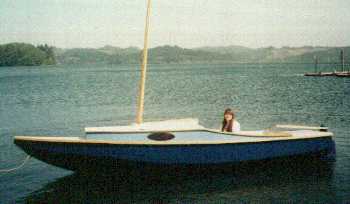
FROLIC2, CUDDY MULTI SKIFF, 20' X 5', 400 POUNDS EMPTY
The photos show the prototype Frolic2 built by Larry Martin of Coos Bay, Oregon. Larry built the boat quite quickly this past winter including sewing the sail to the instructions given in the plans. He reported sailing it for the first time on a ripping day with an occasional 2' wave. I always advise testing a new boat in mild weather, especially a new design, but Larry got away with it. Looking at his photos, the neat work, and simple efficient rigging suggests to me that Larry has been sailing small boats a long time.
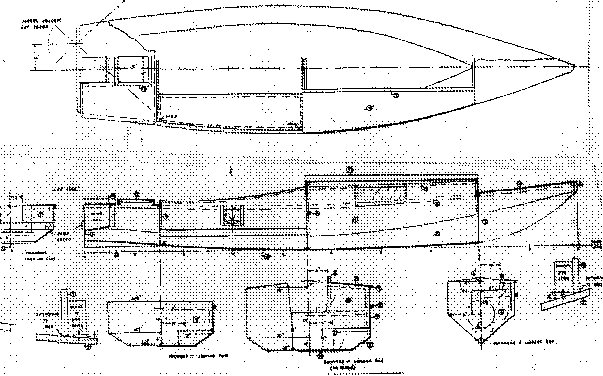
Frolic2 has a small cabin, probably only for one to sleep in because the multichines that make the boat good in rough water also rob you of floor space. To say it another way, the nice big floor space of a flat bottomed sharpie is what pounds in rough water and makes you uncomfortable. But Frolic2 has a 6' long cockpit so someone could sleep there too. There is bench seating. The cabin top has a slot top down the center and you can stroll right through the cabin standing upright in good weather and out the front bulkhead to the beach. The mast is offset to one side so you will need not have to step around it. Phil Bolger showed us how to do this about 15 years ago and it works. But Larry went conventional with his boat, mounting the mast on centerline and decking in the front of the cabin. On a slot top cabin you use a simple snap on tarp to cover the slot in rain or cold or bugs.
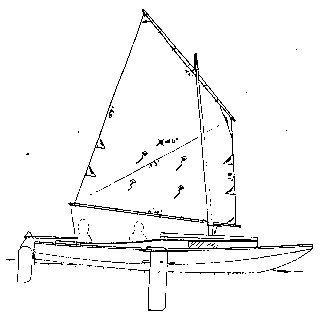
Frolic2 was designed for rough water, long and lean, especially in the bow, and with multiple chines. She's really a takeoff of my Toto canoe in shape. Larry omitted the motor well you see in the lines, and the oarlocks too (The wind must blow just right all the time in Oregon?) but I intended this to be a multi skiff sort of boat with rowing and motoring abilities. You can't row a boat of this size in any wind or waves but in a calm you can travel far if you have patience. I didn't fool around with a gadget motor mount - I put the motor well right in the middle and offset the rudder instead of the other way around. This worked out very well on the high powered Petesboat. We'll see how it goes on a narrow boat because the second prototype is getting the blueprint well as you see in the photo below of the Colorado Frolic2 still being built. You need little power on a boat like this, 2 or 3 hp is more than enough.
The lug rig is for quick easy stowing, rowing, and towing. (The blueprint sail is actually the same size and shape as that of a Bolger Windsprint, a boat which weighs maybe a third as much as Frolic2 and is much narrower. But I think the Windsprint might be over sparred for its size and weight.) Larry reports the rig is about right for the boat, sailing fine with a reef in and three adults on a windy day. The lug sail can be closer winded reefed than when full, perhaps because the sail is then shorter and the yard better controlled (less sail twist). For that matter a sharpie sprit sail the same size as the lug might be smarter in rough water conditions if you can live with the long mast. Switching rigs won't be hard. The mast can be relocated almost anywhere in the slot top without altering the hull to any degree. You just need extra partner and step fittings.
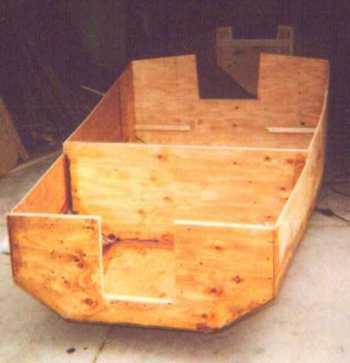
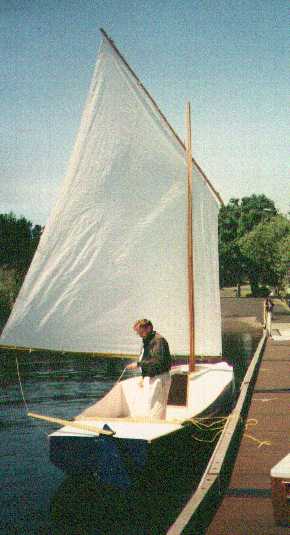
Update, 2006. Jeff Blunk's Colorado Frolic2 eventually found its way to Illinois and then to our Rend Lake Messabout in the hands of Richard Harris. We had a chance to try it out and I was quite pleased. It was fast and powerful. At one point with three men on board, with Max at the tiller, I went forward to tweak the sail which took a couple of minutes with me staring up at the sail. That done I looked back and saw that we were really rolling along.
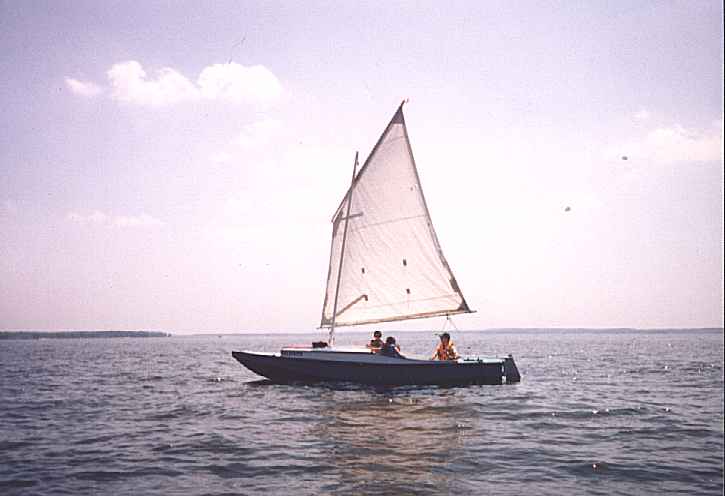
And Gary Blankenship's Frolic2 completed the Everglades 300 mile challange with him reporting sailing for hours at 7 knots or more. Last count he completed three of the challenges with a 4th overall in 2007. Here is Gary's Frolic2:
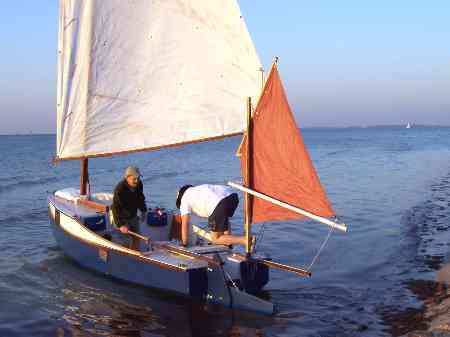
Construction is with taped seams from eleven sheets of 1/4" plywood and two sheets of 1/2" plywood.
Plans for Frolic2 are $35.
Prototype News
Some of you may know that in addition to the one buck catalog which now contains 20 "done" boats, I offer another catalog of 20 unbuilt prototypes. The buck catalog has on its last page a list and brief description of the boats currently in the Catalog of Prototypes. That catalog also contains some articles that I wrote for Messing About In Boats and Boatbuilder magazines. The Catalog of Prototypes costs $3. The both together amount to 50 pages for $4, an offer you may have seen in Woodenboat ads. Payment must be in US funds. The banks here won't accept anything else. (I've got a little stash of foreign currency that I can admire but not spend.) I'm way too small for credit cards.
I think David Hahn's Out West Picara is the winner of the Picara race. Shown here on its first sail except there was no wind. Hopefully more later. (Not sure if a polytarp sail is suitable for a boat this heavy.
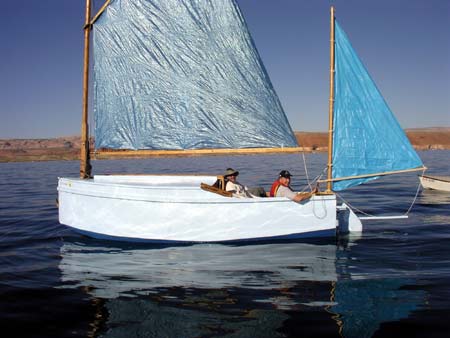
Here is a Musicbox2 I heard about through the grapevine.
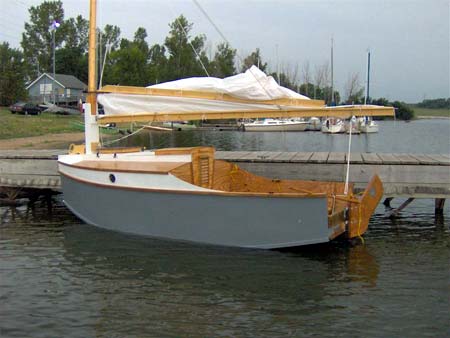
This is Ted Arkey's Jukebox2 down in Sydney. Shown with the "ketchooner" rig, featuring his own polytarp sails, that is shown on the plans. Should have a sailing report soon.
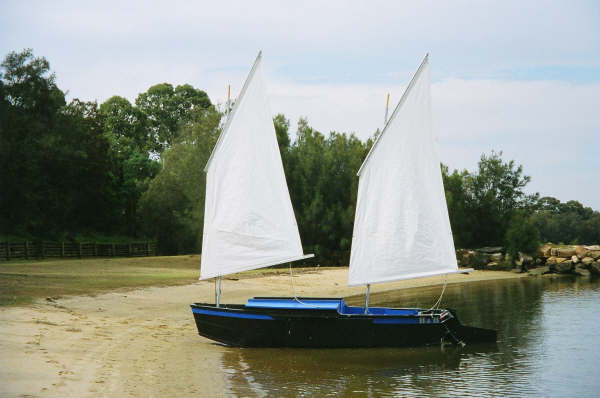
And the Vole in New York is Garth Batista's of www.breakawaybooks.com, printer of my book and Max's book and many other fine sports books. Boat is done, shown here off Cape Cod with mothership Cormorant in background, Garth's girls are one year older. Beautiful job! I think Garth is using a small lug rig for sail, not the sharpie sprit sail shown on the plans, so I will continue to carry the design as a prototype boat.
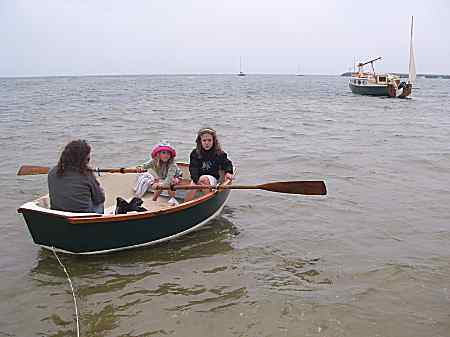
And a new Down Under Blobster, now rightside up for final finish. Looks like another beautiful job....
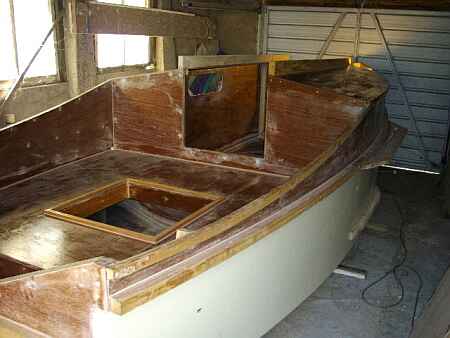
A view of the Caroline prototype showing a lot of the inside, crew on fore deck. Beautiful color:
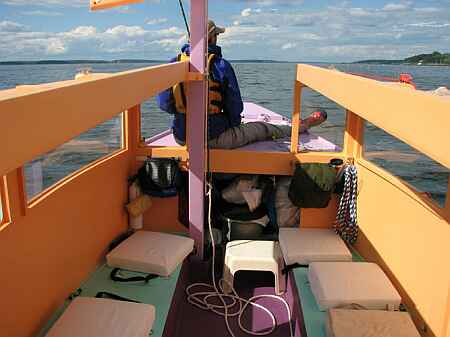
I gotta tell you that on the Caroline bilge panels I made an error in layout and they are about 1" too narrow in places on the prototype plans. I have them corrected but it always pays, even with a proven design, to cut those oversized and check for fit before final cutting.
AN INDEX OF PAST ISSUES
Hullforms Download (archived copy)
Plyboats Demo Download (archived copy)
Brokeboats (archived copy)
Brian builds Roar2 (archived copy)
Herb builds AF3 (archived copy)
Herb builds RB42 (archived copy)